Ripping logs — cutting wood lengthwise along the grain — is one of the toughest tasks a chainsaw can handle. Unlike cross-cutting, which slices across the fibers, ripping requires precision, patience, and the right equipment. In 2025, modern chainsaws have become powerful enough to handle this kind of demanding work without the noise, smoke, or maintenance of older gas models. Still, not every saw is designed for it. Finding the best chainsaw for ripping logs means understanding how power, bar size, and chain design come together to deliver clean, controlled cuts.
The key to ripping efficiency starts with the chain. Standard chains are built for cross-cutting and tend to tear wood fibers when cutting along the grain. Ripping chains, on the other hand, use teeth with a shallower cutting angle — typically around 10 degrees instead of the standard 30. This subtle difference produces smoother, straighter cuts with less strain on both the motor and operator. Choosing the right chain for your saw is just as important as choosing the saw itself, a principle echoed in Five Tool Maintenance Habits Every Maker Should Know in 2025 — attention to small details determines performance and longevity.
For most log-ripping applications, bar length plays a critical role. A 20-inch or longer bar is ideal for slicing through thick logs efficiently, though smaller models can work for shorter or narrower timber. Chainsaws built for this kind of sustained cutting often feature high-torque brushless motors, automatic oilers, and balanced designs to reduce fatigue during long sessions. These same ergonomic considerations are part of what defines the modern workshop, as described in How to Build a Workshop That Thinks for You (Without Losing Control) — intelligent design enhances precision without taking away control.
Another factor to consider is cooling and lubrication. Ripping puts more pressure on both the chain and bar, generating heat faster than standard cuts. Consistent oil flow prevents overheating, extends blade life, and maintains smoother operation. This is especially important when using electric chainsaws, where high torque output and long-duration cutting can stress components. The role of chain oil and lubrication in this context mirrors the discussion in Best Oil for an Electric Chainsaw: Keeping Your Chain Smooth and Safe — friction management is what separates efficiency from failure.
For makers and professionals who process lumber at home, pairing a chainsaw with a ripping mill attachment transforms the tool into a portable sawmill. This setup allows you to produce your own planks, slabs, or beams from raw timber. It’s a cost-effective way to reclaim fallen trees or customize materials for projects. These creative adaptations reflect the evolving craftsmanship mindset explored in From Garage to Smart Studio: The Modern DIYer’s Transformation — where innovation comes from practical problem-solving, not just technology.
Ultimately, the best chainsaw for ripping logs is one that balances strength, stability, and safety. Look for a high-torque motor, long guide bar, proper ripping chain, and a reliable lubrication system. Whether powered by electricity, battery, or fuel, the goal is the same: clean, accurate cuts that bring structure and shape out of solid wood. In an age of digital fabrication, ripping with a chainsaw remains one of the most tactile, rewarding experiences in woodworking — a perfect blend of precision, power, and patience.
